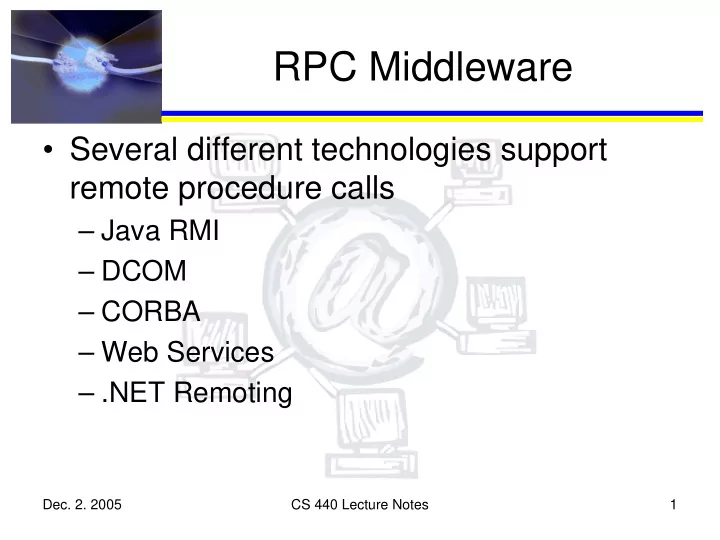

RPC Middleware • Several different technologies support remote procedure calls – Java RMI – DCOM – CORBA – Web Services – .NET Remoting Dec. 2. 2005 CS 440 Lecture Notes 1
Why Call It Middleware? • Supports implementation of the “middle” tier of a three-tiered software architecture Business DB Client Logic Server • Different paradigms – Object-oriented RPC mechanism – Message-oriented middleware (MOM) Dec. 2. 2005 CS 440 Lecture Notes 2
Two-Tiered Architecture • Older architecture for distributed apps DB Client Server • Communication with DB server using some sort of network protocol – ODBC – JDBC – Proprietary from DB vendor Dec. 2. 2005 CS 440 Lecture Notes 3
Java Remote Method Invocation (RMI) • Java’s mechanism for RPC From http://www.aurorainfo.com/wp10/#6 Dec. 2. 2005 CS 440 Lecture Notes 4
RMI (cont.) • API component – stub/skeleton layer – Stub object • Local to client • Acts as surrogate for remote object – Skeleton object • Local to server • Driver for calls to object on server – Both generated from description of object’s interface Dec. 2. 2005 CS 440 Lecture Notes 5
RMI (cont.) • Presentation layer component - Remote Reference Layer – Responsible for marshalling / demarshalling parameters – Intercepts calls from stubs and directs into network interface – Directs calls from network interface to correct skeleton Dec. 2. 2005 CS 440 Lecture Notes 6
RMI (cont.) • Network interface component – Transport Layer – Any networking protocol supported by Java • So the Remote Reference Layer must implement any RPC-specific networking functions (i.e. BLAST, CHAN, SELECT) Dec. 2. 2005 CS 440 Lecture Notes 7
Enterprise Java Beans (EJB) • Popular use for RMI in a three-tiered architecture From http://www.aurorainfo.com/wp10/#6 Dec. 2. 2005 CS 440 Lecture Notes 8
EJBs (cont.) • Based on Java Beans – Spec for designing a software component with a standard interface • Allows manipulation by development tools • EJBs must implement additional interfaces which allow them to be managed by an EJB container or EJB application server Dec. 2. 2005 CS 440 Lecture Notes 9
EJBs (cont.) • Bean divided into two components – Generic EJB object that implements interfaces required to interoperate with app server – Bean class extends generic object, implements actual business logic • Bean thus has two interfaces – Home interface, used by app server – Remote interface, used by client • RMI based Dec. 2. 2005 CS 440 Lecture Notes 10
Java Naming and Directory Interface (JNDI) • Home interfaces for EJBs used to generate home stubs • These are made available via JNDI • Client locates the home stub for a desired EJB using JNDI, invokes create method • Server returns EJB object stub to client, containing EJB interface (including bean methods) Dec. 2. 2005 CS 440 Lecture Notes 11
Common Object Request Broker Arch. (CORBA) • Set of specs developed by Object Management Group (OMG) – Consortium of over 700 developer, vendor, and end user groups • OMG created an Object Management Architecture (OMA) • One component of OMA is the Object Request Broker (ORB) – Responsible for facilitating remote communications Dec. 2. 2005 CS 440 Lecture Notes 12
CORBA (cont.) • CORBA is the set of more detailed specifications for the ORB • Main features: – ORB Core – Interface Definition Language (IDL) – Interface Repository – Language Mappings – Stubs and Skeletons – Dynamic Invocation and Dispatch – Object Adapters – Inter-ORB protocols Dec. 2. 2005 CS 440 Lecture Notes 13
ORB Core • Similar in function to EJB app server • Deliver requests to objects, return responses to clients • Hides details of object – Location – Implementation (language, OS, hardware) – Execution state (active, suspended, deleted) – Communication mechanism Dec. 2. 2005 CS 440 Lecture Notes 14
OMG Interface Definition Language (IDL) • Standardized way of specifying object interfaces • Language independent • Provides well-defined set of types – Basic types like long, double, boolean – Constructed types like struct and union – Template types like sequence and string Dec. 2. 2005 CS 440 Lecture Notes 15
IDL (cont.) • Types used to define interfaces • IDL supports inheritance, so interfaces can be defined that extend other interfaces • IDL also supports definition of exceptions • Example: – module Stats { interface EUStats { string getMainLangs(in string countryname); long getPopulation(in string countryname); string getCapital(in string countryname); }; }; Dec. 2. 2005 CS 440 Lecture Notes 16
Language Mappings • Use a tool to create stubs and skeletons for a specific language from IDL • Defined mappings: Ada, C, C++, COBOL, Java, LISP, Perl, PL/1, Python, Smalltalk, XML, COM bridge • Mapping CORBA to non-objected oriented languages is difficult and cumbersome to use, but possible Dec. 2. 2005 CS 440 Lecture Notes 17
Stubs and Skeletons • Similar to those used byRMI • Stub is proxy or surrogate for remote object – Responsible for marshalling/unmarshalling – Provides interface to ORB • Skeleton is driver for server side object Dec. 2. 2005 CS 440 Lecture Notes 18
Inter-ORB Protocols • Designed for interoperability – Guarantee that IDL types and object references are consistent between different implementations • General InterORB Protocol (GIOP) – Transport independent specification • Internet InterORB Protocol (IIOP) – Specifies how GIOP is mapped to TCP/IP Dec. 2. 2005 CS 440 Lecture Notes 19
Recommend
More recommend